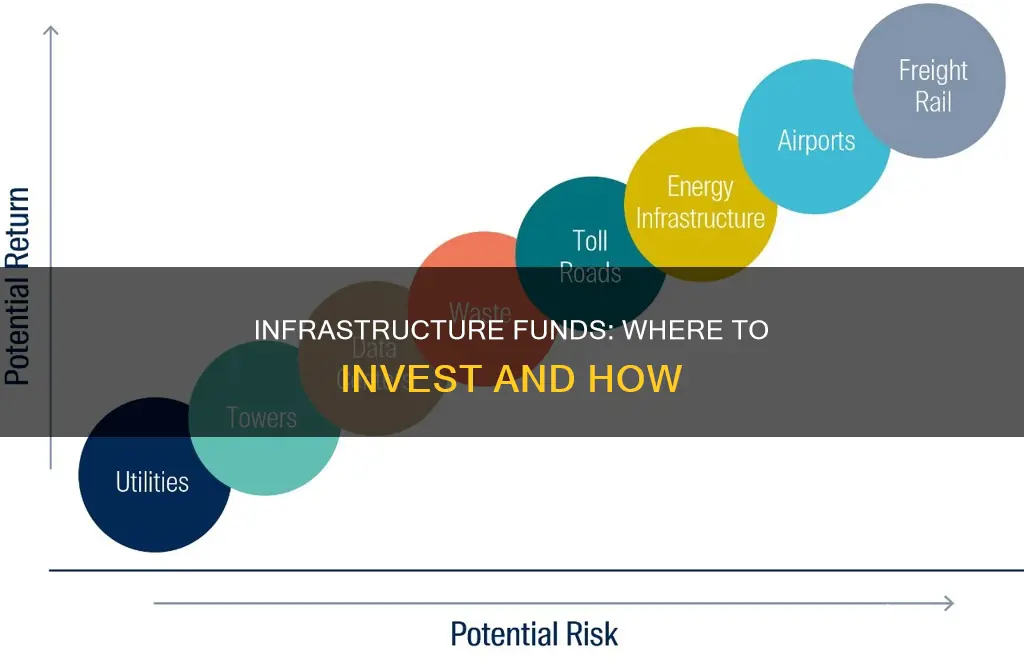
Infrastructure funds are an increasingly popular investment choice, offering a safe haven in turbulent economic times. They are a form of real assets, encompassing physical assets that are essential to a country's development, such as bridges, roads, and energy infrastructure. Infrastructure funds are attractive to investors due to their stable and predictable cash flows, low variable costs, and non-cyclical nature. The funds invest a significant portion of their assets in stocks of companies engaged in infrastructure activities, spanning diverse sectors such as waste management, airports, shipping, and utilities. In recent years, the private infrastructure market has more than tripled in size, with unlisted infrastructure funds raising over $550 billion in the past decade. This article will explore the key reasons why infrastructure funds are a compelling investment option and provide an overview of the different types of infrastructure funds available.
| Characteristics | Values |
|---|---|
| Investment Objective | Long-term foundational allocation, diversification, income, consistent returns |
| Investment Types | Contracted power, regulated utilities, GDP-linked assets, wind, solar, and natural gas generation assets, electricity transmission and distribution facilities, gas distribution systems, pipelines, district heating, water distribution and waste water collection and processing assets, toll roads, bridges and tunnels, airports, seaports, liquid bulk and other storage facilities, parking facilities, rail cars and lines, electric-vehicle (EV) charging networks, battery storage, hydrogen distribution, smart motorway and rail technology, 5G telecom networks, data centers |
| Investment Funds | Lazard Global Listed Infrastructure Port, Nuveen Global Infrastructure Fund, abrdn Global Infrastructure Fund, Cohen & Steers Global Infrastructure Fd, ClearBridge Global Infrastructure Inc Fd, Frontier MFG Core Infrastructure Fund, First Sentier Global Listed Infras Fd, JHancock Infrastructure Fund, MainStay CBRE Global Infrastructure Fund, Russell Inv Global Infrastructure Fund, iShares US Infrastructure ETF, SPDR® S&P Global Infrastructure ETF, ProShares DJ Brookfield Global Infras, Global X US Infrastructure Dev ETF, FlexShares STOXX Global Broad Infras ETF, iShares Global Infrastructure ETF, iShares Environmental Infras & IndstrETF, VanEck® Green Infrastructure ETF, JPMorgan Sustainable Infrastructure ETF, SPDR® S&P Kensho Intelligent Strctr ETF |
| Investment Amounts | $440.00 M, $41.44 M, $758.17 M, $132.49 M, $428.01 M, $104.77 M, $610.31 M, $283.99 M, $428.44 M, $131.49 M, N/A, N/A, N/A, N/A, N/A, $26.03 M, $15.09 M |
| Investment Strategies | Core, core-plus, value-add, opportunistic, distressed infrastructure investing, debt infrastructure funds, digital infrastructure or data centers, energy transition |
| Investment Risks | ESG risk, political risk, construction risk, CAPEX overruns |
What You'll Learn

The benefits of investing in infrastructure funds
Inflation Hedge
Infrastructure assets tend to be inflation-resistant. As replacement costs for physical assets increase during inflation, they protect the value of infrastructure investments. Additionally, fees for infrastructure use are often linked to inflation through regulated frameworks or contractual agreements.
Stable and Predictable Cash Flows
Infrastructure investments generate stable and predictable cash flows due to their long-term contracts and revenue models linked to inflation. These investments are in essential services that experience inelastic demand, ensuring consistent revenue even during economic downturns.
Long-Term Growth Potential
Infrastructure funds offer long-term growth potential by investing in strategic projects during development and operational stages. Upgrading existing infrastructure and building new assets are long-term endeavours that provide stable revenue streams over time.
Residual Value and Resilience
Infrastructure investments are backed by tangible assets with residual value, providing comfort to investors during economic downturns. These assets often have long operational lifespans, with little risk of becoming redundant or technologically obsolete.
Broad Diversification
Infrastructure funds provide broad diversification by country, sector, and holdings. They offer access to high-quality infrastructure assets, such as airports, seaports, and public transportation systems, which are not highly correlated with other major asset classes.
India's Alternative Investment Funds: Exploring the Options
You may want to see also

Industries that are part of the infrastructure sector
Investing in infrastructure has traditionally been seen as a stable and predictable way to generate returns, even through chaotic periods. However, the sector is changing, with revolutions in energy, mobility, and digitization introducing new dynamics.
Transportation Systems
This includes roads, highways, bridges, tunnels, airports, seaports, parking facilities, rail cars and lines, electric-vehicle (EV) charging networks, and smart motorway and rail technology. These are considered hard infrastructure, or the physical networks necessary for the functioning of a modern industrial society.
Energy
This covers contracted power, regulated utilities, electricity transmission and distribution facilities, gas distribution systems, pipelines, district heating, and renewable energy power plants. The energy sector is undergoing a transition, with fuel sources and related assets being phased out, and investors need to be aware of the changing risk profiles of these investments.
Water and Wastewater Systems
Water distribution and wastewater collection and processing are essential components of infrastructure. Sustainable water infrastructure focuses on providing communities with sufficient access to clean, safe drinking water, as well as effective management of water resources.
Telecommunications
Telecom networks, such as 5G, mobile towers, fiber-optic technology, and data centers, are now considered core infrastructure. These networks are crucial for connecting communities and supporting business operations.
Healthcare and Public Health
Healthcare and public health infrastructure include hospitals, schools, and law enforcement agencies. These are classified as soft infrastructure, which encompasses the institutions that maintain the economic, health, social, environmental, and cultural standards of a country.
Other Industries
Other industries that are part of the infrastructure sector include emergency services, government services and facilities, critical manufacturing, defense, food and agriculture, financial services, and information technology.
Mutual Fund Investment: Answers to Your Questions
You may want to see also

Examples of the best infrastructure funds
International Public Partnerships (INPP)
An investment trust that aims to invest in social and public infrastructure responsibly and deliver long-term growth for shareholders. INPP invests in a diversified portfolio of 143 infrastructure assets and businesses related to energy distribution and transmission, transport, education, health, justice, and digital infrastructure projects. The fund is well-diversified and provides broad exposure to structural growth themes within the infrastructure sector, making it suitable for investors seeking stable, long-term, inflation-linked returns.
M&G Global Listed Infrastructure
An open-ended investment company that aims to provide capital growth and income higher than the MSCI All Country World Index. The fund invests at least 80% of its assets in shares issued by infrastructure companies, investment trusts, and real estate investment trusts globally, including emerging markets. M&G Global Listed Infrastructure focuses on sectors such as utilities, energy, transport, health, education, security, communications, and transactions. This fund suits investors who can tolerate higher risk and seek higher-than-average dividend growth.
Pantheon Infrastructure plc
Launched in 2021, Pantheon Infrastructure offers exposure to a global, diversified portfolio of high-quality infrastructure assets with strong defensive characteristics and environmental, social, and governance (ESG) credentials. The investment trust focuses on sectors like digital infrastructure, power and utilities, transportation and logistics, renewables and energy efficiency, and social infrastructure. Pantheon is committed to a dozen infrastructure assets in North America and Europe, including Zenobe, Global Connect, GD Towers, and National Broadband Ireland. This fund is suitable for investors seeking both capital and dividend growth, as the performance of the assets has been strong.
The Renewables Infrastructure Group (TRIG)
TRIG is an investment company primarily focused on wind and solar energy infrastructure in the UK and Europe, aiming to provide shareholders with long-term, sustainable income. The fund's ESG objectives include mitigating climate change, preserving the natural environment, positively impacting communities, and maintaining ethics and integrity in governance. Geographically, TRIG focuses on the UK (at least 35% of the portfolio) and other parts of Europe, including France, Germany, the Nordic region, Ireland, and Iberia. The fund offers diversified exposure to European renewable energy assets contributing to a net-zero carbon future, with strong inflation linkage.
Brookfield Asset Management
Brookfield Asset Management is one of the largest infrastructure investment managers, with a strong liquidity position and a diversified portfolio spanning various sectors and regions. The firm successfully raised $20 billion for its latest infrastructure fund and has essential service assets in renewable power, data, and utilities. Brookfield's infrastructure group has experienced an uptick in demand during economic swings and is well-positioned to benefit from its diverse range of assets.
Strategies for Investing in Quantitative Hedge Funds
You may want to see also

How to invest in infrastructure funds as a beginner
Infrastructure funds are a form of investment in "real assets", which contain physical assets seen in everyday life like bridges, roads, highways, sewage systems, or energy. These assets are crucial to a country's development and offer stable and predictable cash flows.
Infrastructure funds are often seen as a safe haven in challenging economic times due to their countercyclical nature, non-correlation with the stock market, and lower-risk profile. They have been a bright spot, drawing continued interest from investors, even amidst the headwinds facing private equity fundraising. The private infrastructure market has more than tripled in size since the global financial crisis, with over $550 billion raised by unlisted infrastructure funds in the past decade.
Understanding the risks and rewards
Infrastructure funds span a diverse range of sectors, strategies, and geographies, offering a spectrum of risk and reward profiles. Core and core-plus funds have a lower risk-return profile, while value-add, opportunistic, and distressed infrastructure funds offer higher potential returns with correspondingly greater risk.
Getting started with infrastructure funds
Infrastructure funds can be a good fit for individual investors who are new to private markets, especially core and core-plus funds that are open-ended with periodic redemption rights. These funds offer the potential for consistent returns and are relatively easier to understand for beginners. The intrinsic appeal of investing in "real assets" that are highly valued in society and essential to daily life makes infrastructure funds attractive to high-net-worth and retail investors.
Where to invest?
When considering where to invest, look for funds with a strong focus on the transition to cleaner energy and digitalisation. The energy transition and digitalisation mega-trends are reshaping the infrastructure landscape, and funds focused on these areas can provide attractive opportunities. Additionally, government support, such as the Inflation Reduction Act, further bolsters the case for investing in infrastructure.
Final thoughts
Remember that infrastructure investing is a complex landscape, and it's essential to do your own research and consult with financial professionals before making any investment decisions.
A Smart Guide to Index Fund Investing
You may want to see also

The risks of investing in infrastructure
Investing in infrastructure has traditionally been seen as a stable and predictable option, but it is not without its risks. Here are some key risks to consider:
Regulatory Risk
Legislative changes can impact partnerships and pricing structures in infrastructure projects. While investing in countries with stable regulatory regimes, such as OECD nations, can minimise this risk, it is still important to be aware of the potential for regulatory shifts that could affect your investment.
Construction Risk
Infrastructure projects, especially those in the early stages of development, can be susceptible to higher-than-expected costs and delays in completion. Greenfield projects, in particular, may face higher barriers to entry and greater uncertainty. To mitigate this risk, mechanisms such as milestone payments and economies of scale can be implemented to keep costs down and incentivise timely completion.
Merchant Risk
This risk is prevalent in unregulated assets, such as energy, where revenues depend on the sale price exceeding the production cost. High market volatility can significantly impact revenues in these cases. Hedging strategies and long-term contracts, such as Power Purchase Agreements, can help mitigate this risk to some extent.
ESG Risk
Environmental, Social, and Governance (ESG) risk is a significant consideration in infrastructure investments. Large-scale projects can disrupt social communities and cause environmental pollution and hazards during the construction phase. It is crucial to address these risks and implement measures to minimise negative impacts.
Political Risk
Different governments have different approaches to infrastructure development and regulation. Investments in emerging markets, such as Brazil or India, may face higher political risks compared to more developed nations like the United States. Political decisions can impact the stability and predictability of cash flows in infrastructure projects.
Interest Rate Risk
Infrastructure investments often involve high levels of leverage due to their stable and predictable cash flows. However, this also results in high-interest costs. If the revenue-generating abilities are insufficient to cover the interest payments, it could pose a significant risk to the asset's financial viability.
Dividend Fund Investment: A Guide to Smart Investing
You may want to see also
Frequently asked questions
Infrastructure funds are a form of investment in ""real assets", which contain physical assets that we see in everyday life like bridges, roads, highways, sewage systems, or energy. Infrastructure funds invest more than 60% of their assets in stocks of companies engaged in infrastructure activities.
Infrastructure funds are seen as a safe investment due to their countercyclical nature, non-correlation with the stock market, and lower risk profile. They offer stable and predictable cash flows, low variable costs, and are non-cyclical.
Examples of infrastructure funds include iShares US Infrastructure ETF, Nuveen Global Infrastructure Fund, and Cohen & Steers Global Infrastructure Fund.







